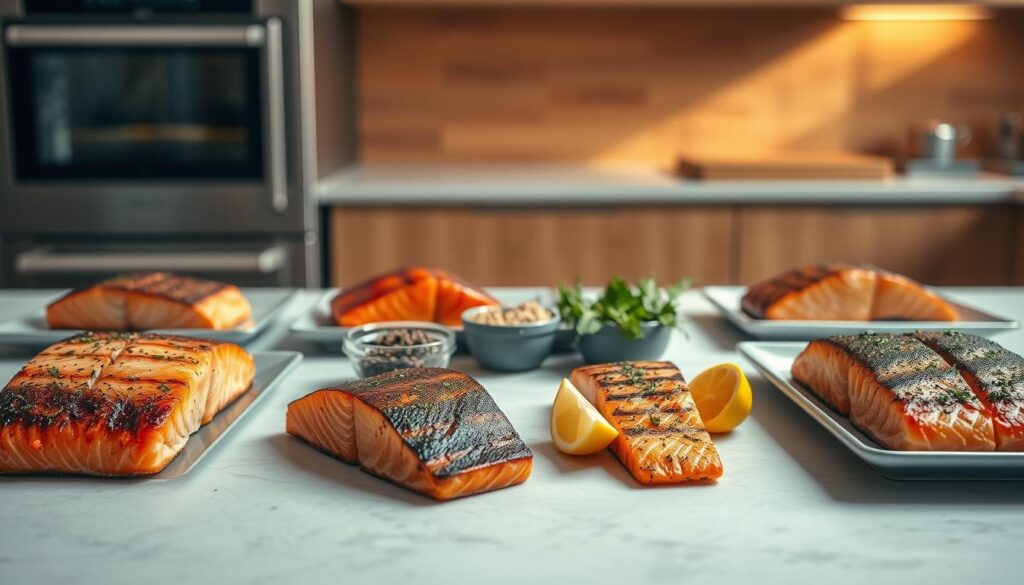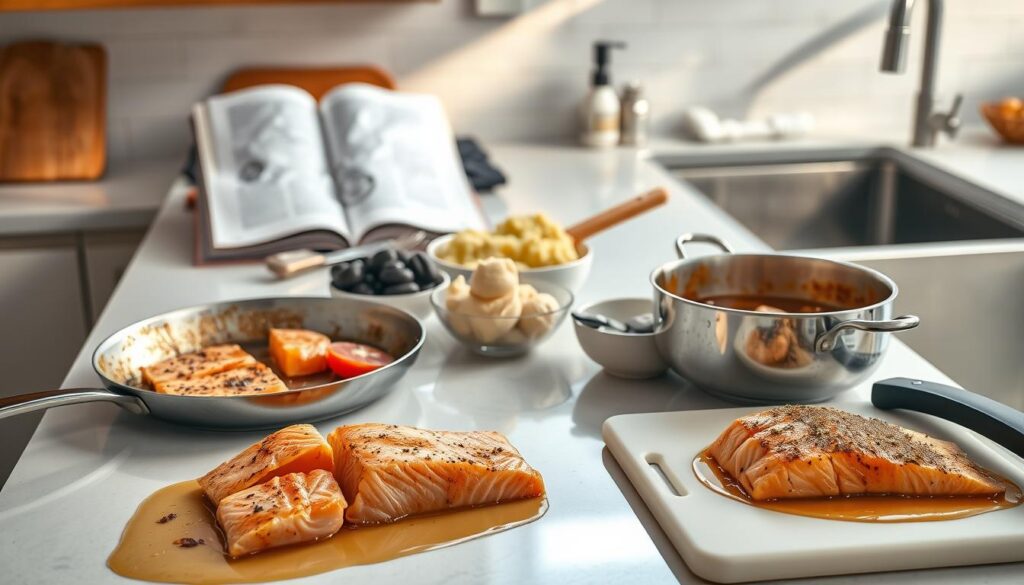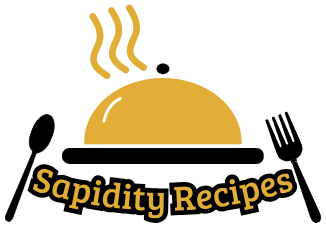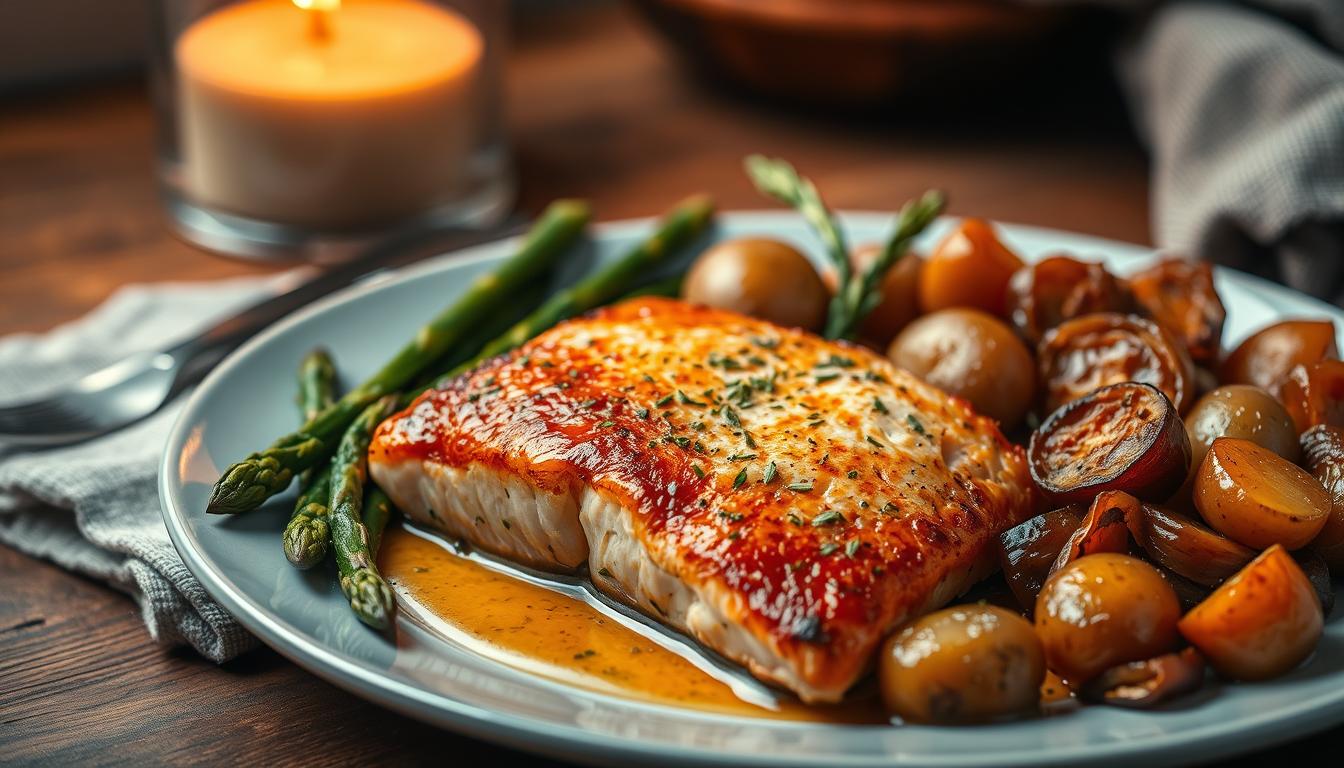How to Make the Best Salmon Recipe for a Perfect Dinner
Cooking the perfect salmon can turn a simple dinner into a memorable meal. I remember the first time I made an amazing salmon dish. The rich flavor and soft texture made me love seafood again. Your journey to making the best salmon recipe starts here.
Salmon is more than just a fish; it’s a nutritional powerhouse. It adds incredible taste and health benefits to your meals. Whether you’re experienced or new to cooking, this guide will help you impress everyone with your salmon dish.
A great salmon recipe is simple yet versatile. You’ll learn how to pick the freshest fish and master cooking techniques. You’ll take your dinner from ordinary to extraordinary. Get ready to discover the secrets of making the most delicious salmon for your home.
We’ll cover everything you need to know about making the perfect salmon dinner. From choosing the right ingredients to mastering cooking methods, you’ll learn to make a meal that rivals a restaurant. You’ll gain the confidence to cook a top-quality meal in your own kitchen.
Table of Contents
Why Salmon is a Great Choice for Dinner
Finding the perfect dinner can be tough. But fresh wild-caught salmon is a top pick for those who care about health. It’s full of flavor, packed with nutrients, and can be cooked in many ways.
Choosing fresh wild-caught salmon means you get a meal that’s more than just food. It’s a treasure trove of health benefits that can make your dinner special.
Health Benefits of Salmon
Salmon is a nutritional powerhouse:
- It’s full of omega-3 fatty acids for heart and brain health
- It’s a high-quality protein for muscle strength
- It’s rich in vitamins and minerals
- It has antioxidants like astaxanthin
Flavor Profile of Salmon
Salmon’s taste is unique and delicious. Its rich, buttery flavor is both delicate and satisfying. It’s loved by seafood fans and casual eaters alike.
Sustainability of Salmon
Choosing sustainable seafood is important. Wild salmon from places like Bristol Bay, Alaska, is a great choice. It’s good for the planet and full of nutrients.
Selecting fresh wild-caught salmon means choosing a meal that nourishes both your body and the planet.
Ingredients You Will Need
To make a great salmon with lemon butter, you need the right ingredients. These will make the fish taste amazing. Start by picking the best ingredients for a meal you’ll remember.
Fresh Salmon Selection
Choosing the right salmon is key. Look for these things when picking your fish:
- Bright, vibrant color without discoloration
- Firm flesh that springs back when touched
- Clean, ocean-like smell
- Wild-caught or sustainably farmed options
Essential Seasonings for Salmon with Lemon Butter
The classic salmon with lemon butter mix uses simple yet strong seasonings. You’ll need:
| Ingredient | Purpose | Quantity |
|---|---|---|
| Fresh salmon fillets | Main protein | 6-8 oz per serving |
| Unsalted butter | Rich, creamy base | 4 tablespoons |
| Fresh lemon | Bright, citrusy flavor | 1-2 lemons |
| Kosher salt | Enhance natural flavors | 1 teaspoon |
| Black pepper | Subtle heat | 1/2 teaspoon |
Optional Ingredients for Varied Flavors
Try these extra ingredients to make your salmon with lemon butter your own:
- Fresh herbs: Dill, parsley, or chives
- Garlic powder for depth
- Dijon mustard for tang
- Honey for subtle sweetness
- Capers for briny complexity
By picking your ingredients wisely, you’ll make a salmon dish that’s both fancy and tasty. Remember, the quality of your ingredients is what makes a meal truly special.
Preparation Steps for Your Salmon
Getting your salmon ready for cooking is all about the details. The right steps can turn a simple fish into a memorable meal. Whether you’re making a grilled salmon marinade or a seasoned dish, these tips will help you make a tasty dinner.
Thawing Frozen Salmon Correctly
Thawing your salmon right is key to keeping its taste and texture. You can thaw it safely in two ways:
- Refrigerator Method: Put the frozen salmon in the fridge overnight. This slow thaw keeps the fish at a steady temperature.
- Cold Water Method: Put the sealed salmon in cold water for about 1 hour. Change the water every 20 minutes.
Creating the Perfect Grilled Salmon Marinade
A top-notch marinade can make your grilled salmon stand out. Here are the essential ingredients for great flavor:
- Olive oil for moisture
- Citrus juice (lemon or lime) for brightness
- Fresh herbs like dill or parsley
- Garlic and sea salt for depth
Pro tip: Marinate your salmon for 15-30 minutes before cooking. This lets the flavors soak in without damaging the fish.
Preparing Your Cooking Surface
Prepping your cooking surface is crucial for avoiding sticking and ensuring even cooking. For grilling, clean and oil your grates. If using a skillet, heat it to medium-high and add a thin layer of oil. A well-prepared surface is essential for a great grilled salmon marinade.
Cooking Methods to Consider
Preparing salmon is a fun journey with many cooking ways to try. Each method brings out special flavors and textures. You can make an easy baked salmon or get that crispy skin salmon.

Choosing the right cooking method can make your salmon amazing. It depends on your kitchen, time, and taste.
Grilling Salmon
Grilling salmon gives it a smoky taste. To avoid sticking, remember these tips:
- Clean and oil your grill grates well
- Use high heat (400-450°F)
- Cook skin-side down first
- Grill for 4-6 minutes per side
Baking Salmon in the Oven
Easy baked salmon is great for beginners. Baking at 375°F makes it moist and flaky.
| Salmon Thickness | Baking Time |
|---|---|
| 1/2 inch | 8-10 minutes |
| 1 inch | 12-15 minutes |
Pan-Seared Salmon Technique
Pan-searing is perfect for crispy skin salmon. Use a cast-iron skillet for the best results:
- Pat salmon skin dry
- Season with salt and pepper
- Heat skillet with oil until very hot
- Place salmon skin-side down
- Press gently to ensure even contact
Broiling for a Flaky Finish
Broiling is quick for a caramelized exterior. Place the rack 4-6 inches from the heat. Watch closely to avoid burning.
Pro tip: Always let your salmon rest for 3-5 minutes after cooking. This keeps it moist and enhances flavor.
Time Management for Perfectly Cooked Salmon
Mastering salmon cooking times is key to a delicious meal. Getting the timing right can turn a tough fish into a tender, juicy dish. This will surely impress your guests.
Cooking salmon needs attention to detail. The right cooking time depends on several factors. These include the cooking method, the thickness of the fillet, and how done you want it.
Salmon Cooking Times by Method
Each cooking method has its own way to cook salmon perfectly:
- Oven Baking: Typically 12-15 minutes at 375°F
- Grilling: Approximately 4-6 minutes per side
- Pan-Searing: About 3-4 minutes per side
- Broiling: 5-7 minutes total
The Critical Importance of Resting Time
Letting your salmon rest after cooking is crucial. A 3-5 minute rest lets the juices spread evenly. This makes the salmon moist and tender.
| Salmon Thickness | Cooking Method | Approximate Cooking Time |
|---|---|---|
| 1/2 inch | Baking | 8-10 minutes |
| 1 inch | Grilling | 10-12 minutes |
| 1.5 inches | Pan-Searing | 12-15 minutes |
Pro tip: Use a meat thermometer to check the salmon’s internal temperature. Aim for 125°F to 130°F for the best doneness. This keeps the salmon moist and flavorful.
Sides That Pair Well with Salmon
Creating a healthy salmon dinner is more than just the main protein. The right sides can make your meal amazing, boosting both nutrition and taste. Choosing sides that match well will help you make a balanced and tasty plate. This will please your taste buds and meet your nutritional needs.
Recommended Vegetable Sides
Vegetables bring color, texture, and important nutrients to your salmon dinner. Here are some tasty choices:
- Roasted asparagus with garlic
- Honey-glazed Brussels sprouts
- Grilled zucchini with herbs
- Maple-roasted carrots
- Steamed green beans with almond slivers
Delicious Grain Options
Grains offer a filling base for your salmon dish. Choose nutritious options that match the fish’s rich taste:
- Quinoa with fresh herbs
- Wild rice pilaf
- Farro with roasted vegetables
- Couscous with lemon zest
Complementary Sauces and Dips
A great sauce can turn your salmon dinner into something special. Try these tasty options:
- Dill-yogurt sauce
- Lemon-caper vinaigrette
- Honey-mustard glaze
- Cucumber-mint relish
Trying out these sides will help you make a salmon meal that’s both memorable and healthy. It will also make your taste buds happy.
Plating and Presentation Tips
Creating a stunning glazed salmon fillet is like art. It turns a simple meal into a special experience. The way you present it can make it even more appealing.
Presentation is more than just putting food on a plate. It’s about making a visual masterpiece that excites your senses before you even take a bite.
The Art of Plating Salmon
Here are some tips for plating your glazed salmon fillet:
- Use white or neutral-colored plates to make the salmon’s color pop
- Position the fillet at an angle for a dynamic presentation
- Create height by slightly elevating one side of the fish
- Ensure clean plate edges with no sauce drips
Garnishes That Enhance Visual Appeal
The right garnishes can make your glazed salmon fillet stand out. Choose ingredients that look good and taste great:
| Garnish Type | Visual Impact | Flavor Complement |
|---|---|---|
| Fresh Herb Sprigs | Adds Green Freshness | Provides Aromatic Notes |
| Citrus Wedges | Bright Color Contrast | Adds Zesty Brightness |
| Microgreens | Delicate Texture | Subtle Peppery Taste |
Remember, less is often more when it comes to garnishing. Your goal is to enhance, not overwhelm, the beautiful glazed salmon fillet you’ve prepared.
Common Mistakes to Avoid
Making moist salmon recipes is more than just using good ingredients. Even skilled cooks can make mistakes that ruin the fish’s texture and taste. Knowing these common errors can make your salmon dishes much better.

It might seem easy to cook salmon, but many mistakes can ruin your meal. Let’s look at the most common errors that can mess up your moist salmon recipes.
Overcooking: The Silent Flavor Killer
Salmon’s biggest problem is overcooking. When it’s cooked too long, it becomes dry and loses its flavor. Chefs say to:
- Use a meat thermometer to check the internal temperature
- Take salmon off heat when it hits 125°F
- Let it sit for a bit to finish cooking
Underseasoning: Missing the Flavor Potential
Salmon tastes great on its own, but not seasoning enough can make it taste bland. Strategic seasoning can really boost the flavor. Try using:
- Fresh herbs like dill or parsley
- Citrus zest for a bright taste
- Light salt and pepper blends
Skipping the Resting Period
The most forgotten step in making moist salmon is letting it rest after cooking. Cutting into it right away lets juices run out, making it dry. Always let your salmon rest for 3-5 minutes before serving to keep it moist and flavorful.
Ideal Serving Temperature
Temperature is key when serving the best salmon recipe. The ideal serving temperature for salmon is around 145°F. This ensures the fish stays warm and keeps its succulent texture.
| Serving Method | Temperature Range | Recommended Approach |
|---|---|---|
| Home Dining | 140-150°F | Serve immediately after cooking |
| Buffet Style | 135-145°F | Use warming trays to maintain temperature |
Pro tip: Let your salmon rest for a few minutes after cooking. This helps the juices redistribute and keeps the temperature just right. This simple step ensures your best salmon recipe is perfectly prepared and deliciously irresistible.
Storing Leftover Salmon
Your healthy salmon dinner doesn’t have to end after one meal. Proper storage can help you enjoy your salmon for days. It also reduces food waste. Knowing how to store and repurpose leftover salmon can change your cooking routine. It saves you time and money.
When storing your cooked salmon, follow these key guidelines. They help keep its quality and flavor:
- Cool the salmon completely before storing
- Use airtight containers to prevent moisture and odors
- Refrigerate within two hours of cooking
- Store for no more than 3 days
Best Practices for Refrigerating Salmon
Refrigeration is crucial for keeping your salmon fresh. Keep it at or below 40°F to stop bacterial growth. Wrap the salmon tightly in plastic wrap or use a sealed container. This keeps its moisture and prevents odors from other foods.
Creative Ways to Use Leftovers
Leftover salmon offers many tasty options for your next meal:
- Salmon salad with mixed greens
- Cold salmon sandwiches
- Salmon pasta with light cream sauce
- Salmon-topped flatbreads
Pro tip: Cold salmon often tastes better than reheated, as reheating can intensify fishy flavors.
By following these storage and reuse tips, you’ll make the most of your healthy salmon dinner. Enjoy delicious meals all week long.
Final Thoughts on the Best Salmon Recipe
Making the best salmon recipe is not just about following a recipe. It’s about growing your cooking skills. Every time you cook salmon, you learn something new. You find new ways to mix flavors that you love.
Creating the perfect salmon dish is a journey of curiosity and practice. Try out different seasonings, cooking methods, and ways to present your dish. This way, you’ll get better and make a salmon recipe that’s truly yours.
Exploring Flavor Possibilities
Don’t be afraid to try new things. Use unique marinades, spice mixes, or cooking methods that catch your eye. Being open to new ideas will turn simple salmon cooking into a fun adventure.
Seeking Culinary Feedback
Share your salmon dishes with your loved ones. Their feedback can really help you improve. Remember, the best dishes come from trying new things and loving to cook.
Did you like this recipe? Your opinion matters to us.
There are no reviews yet. Be the first one to write one.

